Elevator pitch
France has the second largest population in the EU. Since 2000, the French labor market has undergone substantial changes resulting from striking trends, some of which were catalyzed by the Great Recession. The most interesting of these have been the massive improvement in the education of the labor force (especially of women), the resilience of employment during the Great Recession (albeit with a very late recovery), and the dramatic emergence of very short-term employment contracts and low-income independent contractors, which together fueled earnings inequality.
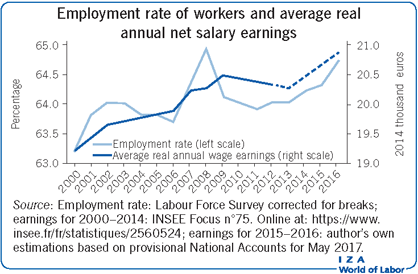
Key findings
Pros
The proportion of tertiary-educated workers is continuously increasing, while their employment rate remains high and acyclic.
The Great Recession did not stop the rise of the employment rate for women, now at its highest level since World War II.
The labor force participation rate of workers aged 50–64 has risen.
Real earnings of the average and median full-time worker have risen.
While remaining somewhat lower, women’s wages have slowly improved relative to men’s.
Cons
Long-term unemployment is far above its pre-Great Recession level; older workers’ unemployment has also risen.
Spatial heterogeneity in unemployment has widened.
The use of very short-term labor contracts (less than a week) has increased dramatically.
Annual salary earnings inequality has increased and is concentrated in the bottom of the distribution.
Traditional artisans are being replaced by new independent contractors with low incomes.
Author's main message
According to unemployment and inequality measures, the French labor market seems to have returned to the state it was in at the turn of the century. However, this simplistic view belies massive change. The educational attainment of the workforce has dramatically improved, pension reforms have stimulated the participation of older workers, and the employment rate has increased despite the 2009 recession. Women have also closed the gender gap in terms of unemployment, though men still enjoy higher wages. Looking ahead, policymakers must decide how to tackle persistent inequality, long-term unemployment, and structural changes in low-income work.
Motivation
France is continental Europe’s second largest economy, but suffers from a 9% unemployment rate. The country’s inability to escape the unemployment trap it has been caught in for decades is perceived as a major concern for the stability of the EU. The OECD Secretary-General Angel Gurria has described himself as having “enormous hope” for the reforms of the recently elected President Emmanuel Macron. However, rather than discussing potential “structural reforms,” this article focuses on important developments in the French labor market during the period from 2000 to 2017, which highlight some key current strengths and challenges for France.
Discussion of pros and cons
Unemployment
Aggregate issues
At the beginning of the millennium, French unemployment was still above 9% according to the definition of the International Labour Organization (ILO). Even so, this was lower than Germany’s rate, and down from its peak in 1997 (10.7%). France had benefited from a remarkable trend in 1998, 1999, and 2000, with three of the four best years for job creation in the 20th century. In 2000, the Council of Economic Analysis (a non-partisan body attached to the prime minister) published a report entitled Plein Emploi, “full employment,” that expressed the economists’ optimism: By 2005, France would enjoy an unemployment rate of around 5% thanks to steady growth, shortening working time, and retirement of the massive cohorts of baby boomers. Unemployment in France (including France Overseas) did continue to decline, but by early 2008 it had reached its trough at 7.2%, far from the full employment objective (Figure 1). The initial scenario was altered by disappointing GDP growth (less than a 2% yearly average) in the wake of the short recession in 2001, by the end of the policy supporting shortened work hours, and by the pension reforms that slowed retirement flows.
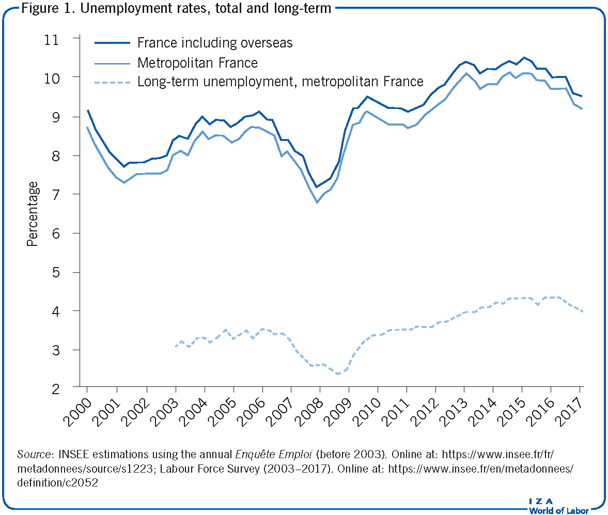
However, some months before the Great Recession, there was again widespread optimism; in just a year, the unemployment rate in metropolitan France had significantly dropped, from 8.1% to 6.8%, the lowest level since 1983. The risk of labor shortages was even an argument for policies conducted by Nicolas Sarkozy (elected in 2007) to boost labor supply at the extensive and intensive margins, that is, via participation and hours (by cutting social contributions and de-taxing overtime hours).
The Great Recession reversed this optimistic expectation. GDP growth was almost flat in 2008, and in 2009 it was shocked by a significant recession (−2.9%). However, this recession was less “Great” than in many other OECD countries, thanks to automatic stabilizers and increased public spending, which included direct support to businesses. The public budget deficit attained record highs: −7.2% in 2009, −6.8% in 2010, and −5.1% in 2011. However, GDP growth did return to its pre-recession rate in 2010, and in 2011 it was above 2%. The unemployment rate basically followed the changes in GDP, even though the “Okun” effect—the short-term correlation between unemployment levels and GDP growth—was far lower than had been observed in previous decades. Unemployment jumped to 9.5% in the third quarter of 2009, and then slowly declined until mid-2011.
In 2011, facing (and acceding to) EU pressure, Sarkozy’s outgoing and then Hollande’s incoming administrations engaged in macro-adjustments [1]. More explicitly, they supported a long-term supply-side policy with massive tax reductions for firms. Despite this costly policy, the budget deficit did decline due to a freeze on civil servants’ nominal wages, cuts in public investments, and the upsurge in direct and indirect taxes paid by households.
While these policies did reduce budget deficits, they also had other less desirable effects. For example, household spending turned negative in 2012. The annual GDP growth rate was only 0.6% from 2012 to 2015. The unemployment rate increased again, reaching its peak of 10.5% in the second quarter of 2015. Eventually, business investment recovered, and a GDP growth rate above 1% in the presence of standstill productivity was associated with a new decline in overall unemployment. The unemployment rate dropping back to single digits coincided with the acceleration of GDP growth in the beginning of 2017. These changes were consistent with the view that the current French unemployment rate had a large component linked to a significant GDP gap.
Despite recent gains, much evidence demonstrates undeniable structural difficulties, while at the same time highlighting strengths in the French labor market. Long-term unemployment (more than 12 months) is among the most worrying problems. From 2008 to late 2016 long-term unemployment exhibited an increasing trend, even during years of economic recovery. It now affects almost one out of every two unemployed workers and is a symptom of several growing divides in the labor market.
Spatial and age divides
Many territories bear scars left by the Great Recession—which accelerated the contraction of the manufacturing sector—and by the restructuring of public services associated with a reduction in public investment. At the same time, workers in these areas face greater obstacles to mobility. In particular, the areas in which job opportunities are concentrated are characterized by dramatic shortages in the availability of housing due to a scarcity of affordable properties and high prices (which only declined slightly in 2009 and then quickly recovered). In Paris, for example, by early 2017 housing prices had climbed 30% above their pre-recession level and 310% above their value at the beginning of the century.
The evolution of the unemployment rate before compared to after the Great Recession versus their initial levels in 2003 compared to 2008 is shown in Panel A compared to Panel B of Figure 2. Spatial heterogeneity in the unemployment rate underwent a dramatic U-turn in 2008. Although unemployment grew in all employment zones (including Paris, where it rose by 1.6 percentage points), the increase in unemployment between 2008 and 2017 was positively correlated with the initial level of unemployment. In the legislative elections of 2017, electors in the two metropolitan zones that experienced the worst deterioration (+5.3 percentage points from 2008 to 2017) elected a leader of the far-right party (in Perpignan) and a Corsican nationalist (in Porto-Vecchio).
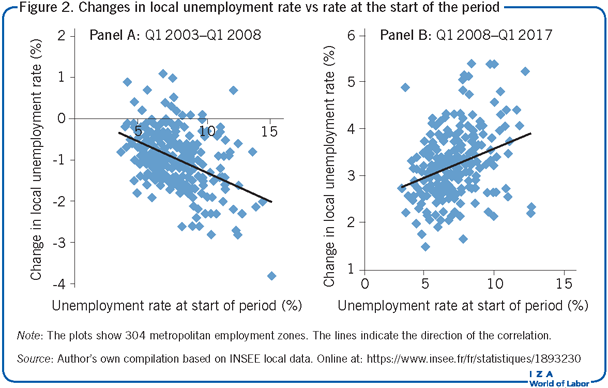
The Great Recession also changed the structure of unemployment, as many laid-off workers eventually fell into long-term unemployment. A second category that partially overlapped with long-term unemployed is aging workers, notably the less educated among them. Public pre-retirement schemes were removed in the early 2000s. From the 1970s to the 1990s, these schemes had made it possible for the economy to absorb a large proportion of the blue-collar workers older than 50 who lost their jobs, especially during downturns. At the same time, progressive pension reforms initiated since 1993 provided strong incentives to lengthen professional careers. Despite these policy changes, before 2008 the increasing participation of workers older than 50—an increase of four percentage points for the 50–64 age group from 2000 to 2008—was quite easily absorbed. The number of unemployed workers by age group and gender in metropolitan France is reported in Figure 3. The number of unemployed workers aged 50 and older was consistently well below 300,000 until the Great Recession.
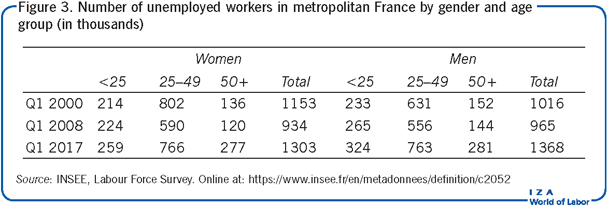
Since 2009, all age and gender groups have been affected by the deteriorating labor market, but the divide between age groups has widened. In particular, the number of unemployed female workers aged 50 or older more than doubled from early 2008 to early 2017, while the increase was less than 30% for those in the younger age groups. Although older workers still enjoyed a significant improvement of their employment rate, this trend was not sufficient to compensate for a jump in the number of participants in the labor market among the 50–64 age group (1.7 million additional participants between 2008 and 2016).
Figure 3 also shows that the Great Recession did not reverse the declining employment gap between women and men, and there is no longer a significant gap. According to provisional statistics, in the third quarter of 2017, the unemployment rate for women is 0.3 percentage points lower than the rate for men (including overseas areas), compared to a gap in favor of men of 2.6 percentage points in 2000. The relative good performance of women younger than 50 is partially explained by the fact that they benefited more from the remarkable educational upgrading of the French workforce during the past three decades.
Workforce composition and employment rate
A much more educated workforce
The substantial upgrading of the workforce’s educational levels is probably the most impressive structural change on the supply side of the French labor market. In the wake of the agenda initiated by François Mitterrand, children born since mid-1975 enjoyed a rapid opening up of access to high school in the 1980s, to some college studies in the 1990s, and then to college graduation in the 2000s. Figure 4 shows that the share of tertiary-educated workers among the working population in the 25–64 age group has exhibited a continuous upward trend, from 25% in 2000 to 39% in 2016. By contrast, poorly educated cohorts have left the labor market during this period. Since 2005, there are fewer people in the labor market with less than lower secondary education than there are workers with a tertiary education.
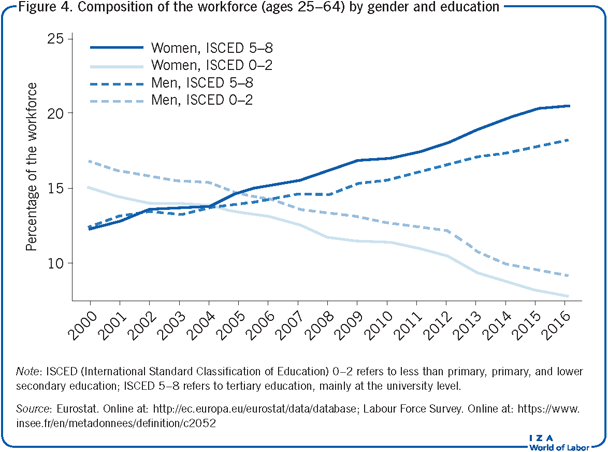
Another striking fact is that a clear majority of active tertiary-educated people are now women, a reflection of the larger proportion of young women engaged in postsecondary education. The entry into the labor market of the first children of the so-called little baby boom (since the end of the 1990s) fed these trends in the two subsequent decades.
Education matters more for getting a job
Due to the upgraded educational attainment of the working-age population, France enjoys an employment rate among the active population aged 15 to 64 that is higher than in the early 2000s. The aggregated impact of the Great Recession has practically been erased, as the Illustration shows.
According to the Labour Force Survey, despite the massive increase in the supply of highly educated workers, their employment rate has remained flat since 2000 at about 84% for the 25–64 age group. Even the Great Recession did not affect it significantly, and the 85% rate in 2016 is the highest level since World War II.
This performance contrasts with the harsh impact of the 2009 recession on less-educated workers. The employment rate of those with less than a secondary education in the 15–64 age group was stable at about 46% from 2000 to 2008, but dropped to 39% in 2016. The employment rate of secondary-educated workers fell from 69% in 2008 to 66% in 2016. These trends also explain the rapidly closing gender gap in employment rates: from 14% in 2000 to roughly 7% today.
Wages development: Conflicting trends
Flat wage inequality?
Using exhaustive logs from employers, the INSEE computes the distribution of the full-time equivalent (FTE) salary in France. Most inequality indexes based on these French statistics follow a U-shaped curve with a low point in 2008. However, the magnitude of the changes is very small. For example, the 50/10 ratio, comparing the median to the bottom decile of the distribution, was 1.53 in 2000, 1.49 in 2008, and 1.50 in 2010. And, by contrast with observations in many countries, the 90/50 ratio, which compares the top decile of the distribution to the median, does not exhibit a growing trend in France. However, this remarkable stability is misleading. The focus on the disaggregated dimensions of wage inequality reveals significant changes with opposite impacts.
The declining public–private and gender gaps
Figure 5 shows the evolution of the average real FTE net wages in the private sector and in public firms from 2002 to 2014. They generally followed labor productivity rates, but did not mirror the business cycle, since they enjoyed growth in 2009 but dropped off during the ensuing recovery. The apparent wage dynamics at the heart of the recession fueled the idea that French workers had a preference for wages rather than employment; recent trends are less consistent with this naïve interpretation of the French unemployment drama.
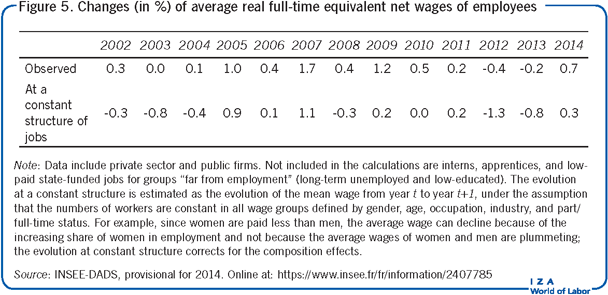
This timing is partially explained by initial increases in nominal industry minimum wages (intended to compensate for the surge in inflation in 2008). However, the main drivers are composition effects; when one controls for the contraction of low-paid jobs in 2009, the average real net FTE wage was flat.
Because of the large share of skilled jobs in the public sector (teachers, doctors, etc.), there was a significant gap in earnings between public employees and workers in the private sector and public firms. However, the freeze on nominal compensation for public employees instituted in 2010 has closed this gap in recent years; according to the latest statistics, in 2014 the average FTE annual wages of private workers had even become slightly larger. Since the majority of public sector employees are women, this freeze has been biased against women. By contrast, the rise of the relative educational attainment of women and their ability to get more skilled jobs in private firms has favored women [2]. This second mechanism dominated the first, and thus the gender wage gap has been declining since the turn of the century; however, it remains significant. In terms of real annual salary earnings, the gender gap was 39% in 2000, 37% in 2008, and still 31% in 2014.
Time-sliced salaried job contracts
Over the past 15 years, the simplification of legal requirements and the digitalization of the recruitment process have caused a rapid growth in hiring in France (Figure 6). The number of newly hired workers is now greater than the stock of employees. Each quarter, hotels and restaurants hire as many workers as the number of salaried positions.
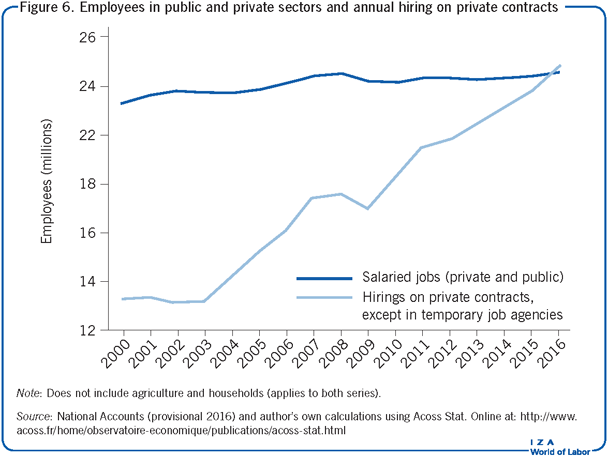
This phenomenon is fueled by the human resources (HR) strategy of replacing long fixed-term contracts with very short temporary contracts—most lasting less than a week—for the purpose of just-in-time adaptation of the workforce. The share of fixed-term jobs has remained steady since 2000, in contrast to the 1980s and 1990s when it was increasing [3], in the neighborhood of 15% of total salaried employment. However, the duration of the contracts has shortened dramatically. Only one out of five short-term contracts is for a month or longer, compared to two out of five in 2000; the median duration is now about eight days. Another essential characteristic of this epidemic is that most hired workers are in fact the same workers being rehired for the same job. By construction, very short-term contracts are excluded from a variety of additional types of compensation set by industry-level agreements for workers that have even minimal seniority.
A million workers who are younger and less skilled now move from unemployment to employment and back to unemployment at high frequency. This causes a new form of underemployment. Slicing work contracts into ever shorter intervals reduces annual earnings at the bottom of the distribution, and the 10th percentile of the labor earnings distribution now falls far below the poverty line. The new working poor have convinced unions and employers’ organizations, which manage unemployment insurance in France, to improve unemployment benefits. From this perspective, the relevant measure of labor activity has come to include not just salaries, but also unemployment benefits. According to the latest statistics, this improvement in benefits seems to have stabilized earnings at the bottom of the distribution (Figure 7).
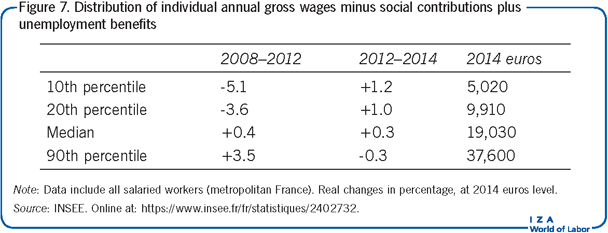
Note that the Labour Force Survey, which uses the ILO’s definition of an unemployed person, cannot capture unemployment periods within a single week. This partially explains why job seekers registered at French job centers (Pôle Emploi) are now far more numerous than unemployed people: At the end of July 2017, Pôle Emploi recorded 5.6 million job seekers (who had not worked during the month or had worked only partially), compared to three million unemployed persons according to official ILO statistics.
The new independent contractors
The changing nature of self-employment is another massive mutation of the French labor market, and it occurred over just one decade. Traditional skilled artisans have been squeezed by the recession and by competition from new entrepreneurs. In 2009, the government introduced the auto-entrepreneur status—now called micro-entrepreneur status. It is now possible to become a micro-entrepreneur in just five minutes via the internet. Micro-entrepreneurs’ social contributions and income taxes are low and proportional to earnings, which can be declared on the internet each quarter, provided they are below certain turnover thresholds. Most of these entrepreneurs do not have to charge a value-added tax, and they can also offer lower prices because they are not subject to many requirements (e.g. professional insurance) imposed on traditional artisans. As the number of classic artisans declined over the past decade, the number of independent contractors grew. The latter group has also experienced an increase in FTE of roughly 5% during this time. However, their real revenue per worked hour dropped by around 15% on average. A new category of working poor is thus emerging: in 2014, the 0.5 million micro-entrepreneurs who were active and who did not cumulate their independent activity with salary income, earned on average less than 500 euros a month.
In the past three years, the emergence of the gig economy has accelerated the development of micro-entrepreneurship, now raising the risk of a shift from salaried jobs—including high-skilled employment—toward independent contracting.
Limitations and gaps
The interplay between the developments of independent contractors and of very-short-term jobs is not well captured by the current surveys or administrative data. For example, do gig jobs provide complementary income to workers on time-sliced salaried contracts, or not? Statistics that take account of this complexity are coming and will help draw a more accurate picture. In terms of welfare, an important question is whether or not these evolutions reflect workers’ aspirations.
Much empirical evidence, including random testing, suggests massive discrimination in the labor market against people with African or non-identifiable (by the employers) backgrounds [4] or those living in deprived areas perceived as having high concentrations of criminals or people unwilling to work. There is also evidence that these populations face discrimination in the housing market, as well as in gaining access to credit for entrepreneurship through private banks and public funding. However, only a few scattered studies (e.g. [5]), and no comprehensive review, exist, since the collection of race and ethnicity statistics is strictly limited in France (this ban remains following the exploitation of such information by the collaborationist government during World War II).
Summary and policy advice
The heated debate on the subject of the labor law in spring 2016 revealed the lack of consensus among French economists on the most effective strategy for tackling mass unemployment in France today. On the one hand, some scholars have supported reforms that would cut employment protection legislation and extend opting-out of industry agreements, in line with recommendations repeated by the IMF and the European Commission since the 1990s.
On the other hand, other academics have questioned the relevance of these arguments, stressing the weight of the macroeconomic environment and the risk of increasing inequality. In line with the latter view, revamping the code du travail is at best a secondary issue compared to discrimination in the labor market and to more recent challenges, such as the housing shortage or plummeting public investment in depressed areas.
During the recent presidential campaign, Emmanuel Macron received recommendations and press support from many economists in the first group. His election will provide a broad natural test of the (in)efficiency of policies such as the primacy of firm-level agreements, the fusion of work councils and health and safety committees, or the binding maxima for workers’ compensation that courts may award in case of wrongful termination. The IMF is enthusiastic: in the Article IV concluding statement published in July 2017, its staff claim that “the government’s ambitious reform program could go a long way addressing France’s longstanding economic challenges.”
Acknowledgments
The author thanks the IZA World of Labor editors for many helpful suggestions on earlier drafts.
Competing interests
The IZA World of Labor project is committed to the IZA Guiding Principles of Research Integrity. The author declares to have observed these principles.
© Philippe Askenazy